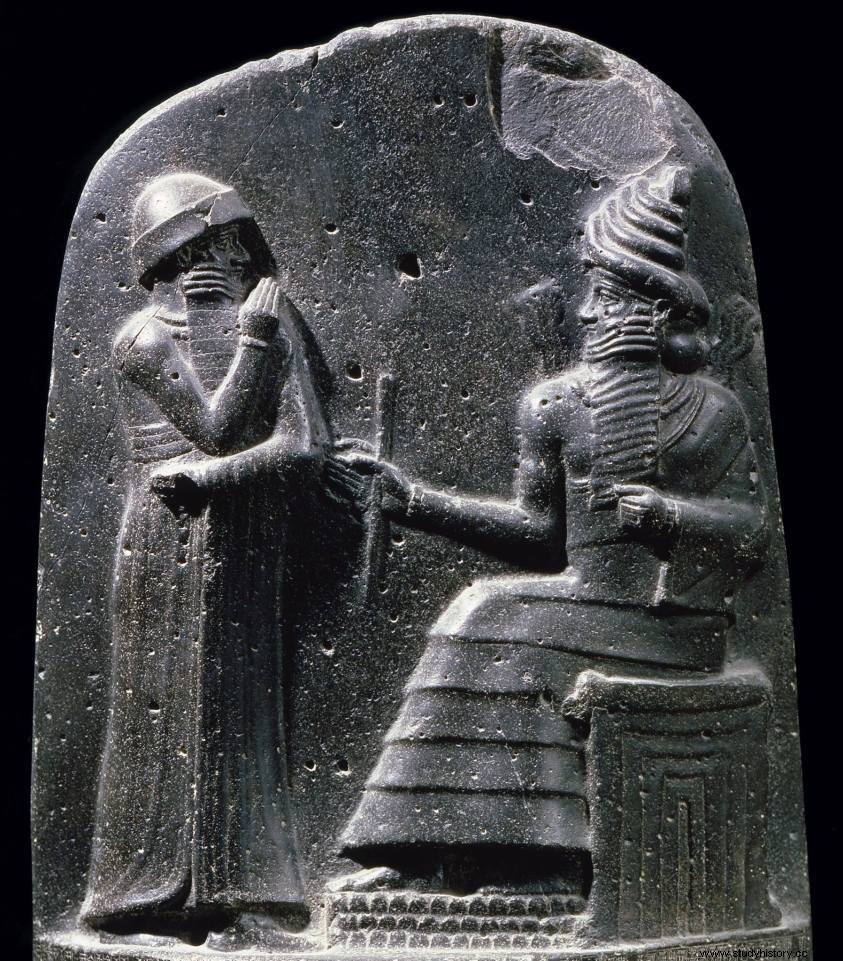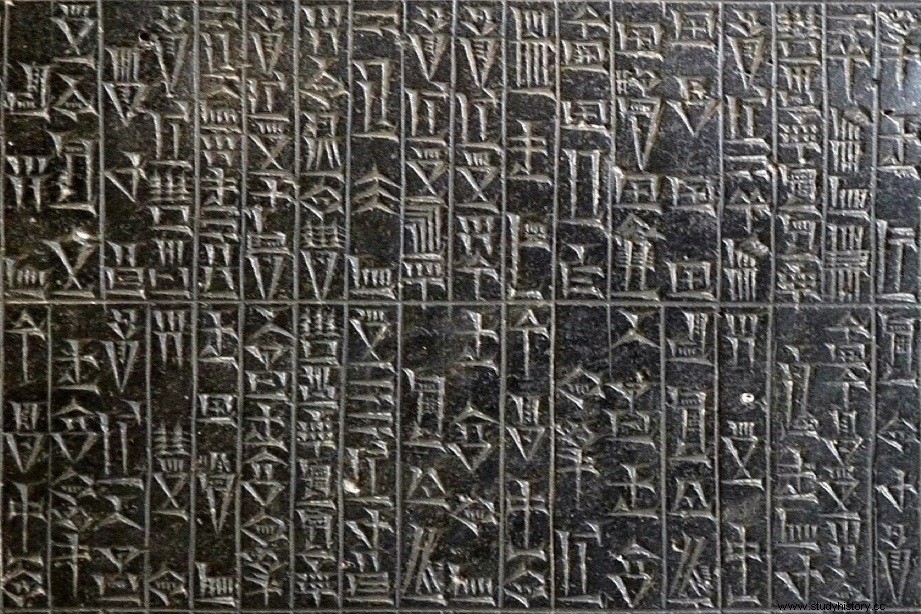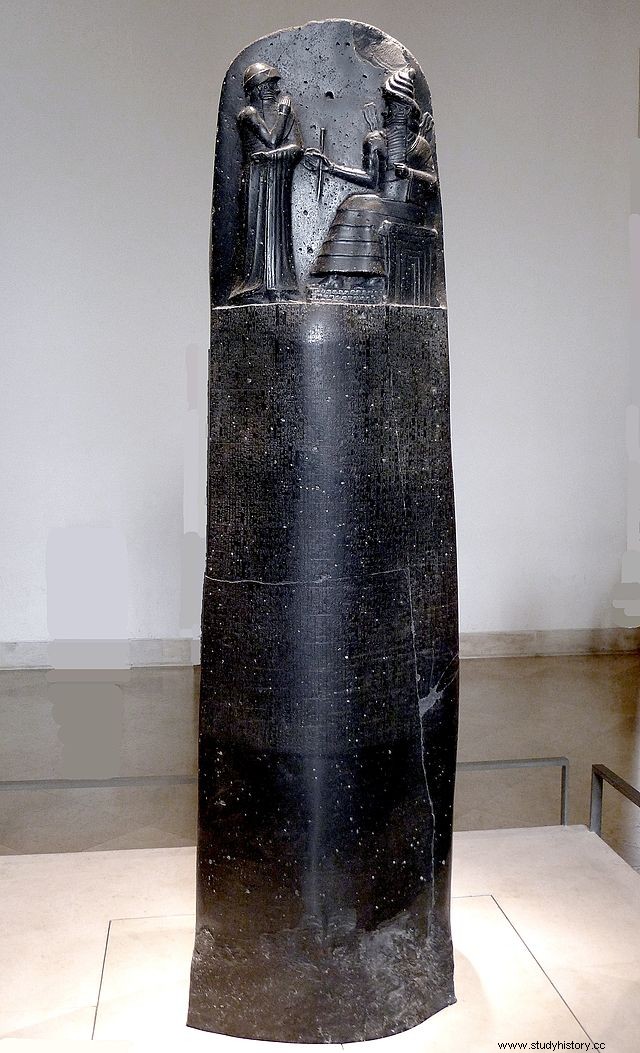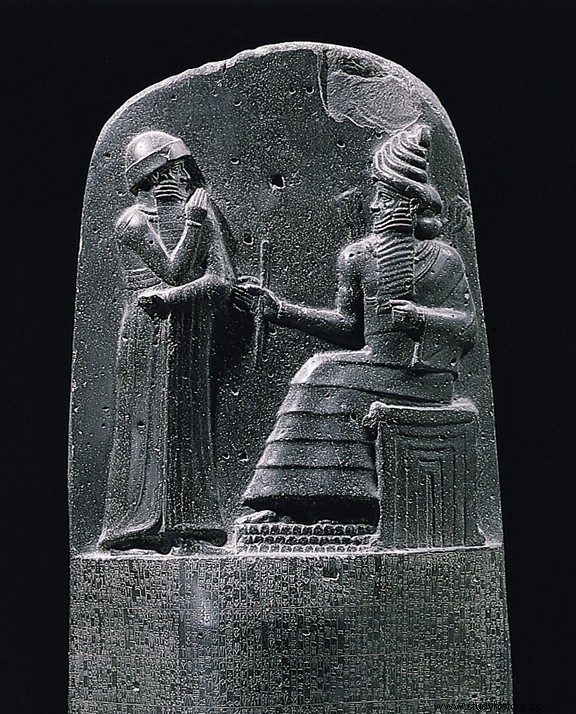
Hammurabi of Babylon
Known as the sixth ruler of the 1st dynasty of Babylon, Hammurabi reigned approximately from 1792 to 1750 BC (probably ascended to the throne in adolescence), bringing the Babylon of the Paleo-Babylonian era to a state of absolute success and splendor, through the unification of almost all of Lower Mesopotamia. Up to that moment, in fact, Babylon had played an important role, but not sufficiently incisive to definitively determine the equilibrium of the Near East. Very scarce and equally unclear are the sources and information in our possession about his political, economic and military career, but above all about his life, which can be placed chronologically between 1810 and 1750 BC approximately, in the middle of the Bronze Age (chronological period conventionally interposed between 2000 and 1500 BC ).

The reign of Hammurabi however, it can be divided into two distinct periods , divided according to its political, economic, social and military activity. The first part of his reign is in fact characterized by a low military commitment, replaced by a more active interest in the economy and construction, which led him to transform Babylon into a magnificent capital full of statues, monuments and gardens. Hammurabi also carried out an intense series of public works to improve the water conditions of the country, in order to facilitate both river and land trade, connecting Babylon with the sea through a channel nicknamed the "Hammurabi channel", useful for intensifying the relations with as many countries as possible in the ancient Near East. A further characteristic of this first phase is also represented by a discreet religious commitment, which led him to elect the god Marduk (polyiad deity of Babylon symbolized by a dragon) as the main protector of his kingdom, forcing all the vassal kingdoms to pay tribute in his honor.
As for the second part of his reign, clearly differentiated from the first, it is possible to speak of an energetic military conquest activity, thanks to which he also skillfully managed to exploit a whole series of alliances that characterize the war, political and economic strategy of the Middle Bronze Age . The extensive conquest of Mesopotamia by Hammurabi begins with the conquest of Elam, a territory east of Babylon which, like Assyria, had always distinguished itself as one of the most intrusive and dangerous neighbors. This victory gave way to a long series of successes in the Near East, such as the conquest of Yamutbal, Larsa and Eshunna, the expedition to the Middle Euphrates and to upper Mesopotamia, and finally the destruction of Malgium and Mari, with the consequent defeat of Zimri-Lim, the last great ruler of Mari with whom he was forced to break an advantageous alliance, betraying him.
It is therefore customary to clearly delineate the reign of Hammurabi in two well-defined phases, to highlight how the young sovereign just ascended to the throne and burdened with numerous responsibilities at first knew how to act with extreme caution, devoting himself more to defensive works against the city of Babylon, to improve the quality of life of his people and, finally, to important liturgical actions to curry favor with both divinities and diviners, a particularly influential component in Mesopotamian society. The gods also represented a constant presence in the life of the men of the Near East, and it was the duty of each sovereign to ensure their benevolence and protection, especially to protect the entire city. Hammurabi was thus preparing the way and the ideal conditions for what would later be one of the greatest empires in the whole of the Near East.
Hammurabi's "code":king and legislator
Although he is widely remembered for a rich and intense series of military conquests and political alliances, as well as for various public and city activities as previously mentioned, what most made Hammurabi famous and noteworthy is above all the promulgation of a dense collection of laws , known today as the “code” of Hammurabi , which also gave him the illustrious title and the name of "sovereign legislator" (a title not common among Mesopotamian rulers). Some historians even believe that he is the first truly great legislator of the Earth, but this is still a much debated topic today. Indeed, the question of Hammurabi's "code" represents an extremely complex and articulated element, on which many questions currently remain.
First of all, we must underline how the term “code” actually represents an anachronistic expression that is not entirely correct, as it would not be a real code of laws, but rather a collection of rules, since unlike our codes of law, it was not conceived in a systematic way for the purpose to organically regulate certain "matters" (such as criminal, civil, tax, etc.). These rules would instead represent a series / collection of exemplary models, without the specific ambition of having to obligatorily regulate all possible legislative cases. At the same time, the "code" would also contribute directly to celebrating the image of the sovereign for propaganda purposes as the main guarantor of justice by divine mandate (the same royal office was the result of a "gift", at the behest of the gods).
As previously mentioned, the exposed standards within the "code" of Hammurabi they were not figured as real laws, but as examples and models presented in the form of hypothetical periods (a characteristic element of almost all the collections of laws found on Mesopotamia, as well as the collection of Ur-Namma, Sumerian ruler of the period of Ur III). However, sometimes the rules also represent the practice documented by the legal documents of the time, such as proceedings, judgments, contracts, etc., although the latter never mention the "code" as the source of the standard applied. It is therefore extremely probable that the collection narrates the "law" that was already exercised by the local authorities, divided on the basis of the arguments and the seriousness of the facts.

The structure of the "code"
Known as one of the first and oldest legislative codes found in Mesopotamian history, the dense inscription in the Akkadian (Paleo-Babylonian) language of the Hammurabi "code" appears to be engraved on a high basalt stele (225 cm x 79 cm x 47 cm). It is an imposing monolith of more than two meters, now exhibited in the Louvre museum, found in an excavation of Susa, in Persia, in 1902 (years of rich archaeological discoveries throughout the Near East), where it may have come as one of the many spoils of war following various looting by the Elamite ruler Shutruk-Nakhunte, around 1155 BC approximately. The main feature of the stele is the excellent state of conservation, which has allowed an almost total decryption of the entire "code".

However, this "code" is also very well known thanks to numerous manuscripts contemporary or from a period subsequent to the date of its engraving; it was in fact a very common process in the Near East to copy and recopy texts considered "classics" for centuries (as the medieval scribe monks did centuries later) for the culture of the Near East, as they became typical texts of the Mesopotamian tradition. The same process was certainly suffered by Hammurabi's "code", who, despite having lost all legal and legislative value over the years, still managed to maintain a strong cultural and social value, which made him the protagonist of a long and famous tradition of the scribal world.
As far as the structure of the "code" in question is concerned, we are faced with an extremely complex and well-organized text . Structured according to the typical casuistic formulation (articulated by hypothetical periods), the text of Hammurabi's "code" is articulated according to a triple distinction in a prologue of opening the laws, the actual text with all the 282 norms, and finally an epilogue final to conclude it all. Prologue and epilogue, although they do not directly represent norms or laws as the "code" should do, are essential as they deal with presenting the figure of the sovereign as devoted to the gods and as a great conqueror; the role of justice therefore appears extremely marginal in an overall picture where Hammurabi is instead the undisputed protagonist attentive to the well-being of the population by divine will (propaganda purpose).
Norms and iconography
As mentioned above, Hammurabi's "code" does not represent a real legislative code, but a set of rules divided and organized by themes and crimes , associated with the related procedures to be followed in case of crimes. They were in fact classifiable more as models than as real laws, and the distinction of punishments took place on the basis of a triple social classification :the lords (awilum), endowed with the highest privileges, the common citizens (mushkenum), and finally the slaves (wardum), considered as an object or private property, and therefore exempt from any possible type of protection. The penalty was therefore proportionate to the value of the person who committed the crime or who was in some way damaged by it.
As for punishments , they were very numerous and varied according to the crime committed and the person who had committed or received it. Capital punishment was quite rare and was applied almost exclusively in the case of murder or treason, there were also various corporal punishments implemented mainly on the basis of the law of retaliation, very popular in the Mesopotamian world as well as in the biblical one, fines were instead they were very frequent and fines of various sizes were imposed on the basis of the crimes committed; finally, another penalty applied rather rarely was exile. The ascertainment of the truth of a crime was also another very important fact to consider, since, in the absence of the flagrantee of the crime, it could take place through written documents, witnesses, oaths and through the proof of the ordeal (still used in medieval times and modern).
Finally, a last considerable factor that characterizes the stele of Hammurabi's "code" is represented by an elaborate iconographic element placed on the top of the monolith. It is a small bas-relief finely worked representing the ruler Hammurabi in front of Shamash, an important deity of the Mesopotamian pantheon relating to the Sun and, precisely, to justice, since being a solar / celestial god, he can see and know everything at any time. Hammurabi is also represented in a typical attitude of great devotion to the god, placing his left arm folded and his right hand in front of his mouth. This iconography is often found in seals and statues from the Near East to symbolize the sovereign's closeness and respect for the deities.

In conclusion, although Hammurabi's "code" is more of a celebratory and propaganda text towards the sovereign, rather than a code with legislative and judicial features, it is essential to outline not only the figure of Hammurabi, but also the ancient Mesopotamian conception that prevailed with regard to jurisdiction. The "code" also made it possible to analyze a complex hierarchical and social stratification of the population, as well as an articulated political, economic and military system operated by Hammurabi during his reign; these are not indifferent issues if we consider that, following the death of the sovereign, everything that had been hard built by him will enter into crisis, since his successors are no longer able to permanently control an empire extended from the Persian Gulf to the high Mesopotamia. The "code" would therefore turn out to be a direct testimony of one of the greatest phases that the Babylonian empire witnessed.
